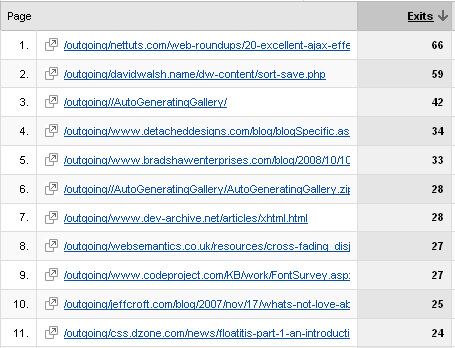Check for Google Analytics Using MooTools 1.2
When I launched my new design last week, I used PHP to comment out Google Analytics because I didn't want to skew the stats. Well, I did skew my stats that day because I forgot to uncomment the damn GA code. Rook move, I know. With that in mind, I've created a MooTools script that checks to make sure Google Analytics is loaded. If not, you get a friendly JavaScript alert() reminder.
The MooTools 1.2 Code
window.addEvent('load', function() {
if(typeof(eval(window)['_ufsc']) == 'undefined') {
alert('David, turn on GA!');
}
});
Not having 10 hours worth of stats is a big deal. This code will (hopefully) prevent this from happening again in the future.
![CSS @supports]()
Feature detection via JavaScript is a client side best practice and for all the right reasons, but unfortunately that same functionality hasn't been available within CSS. What we end up doing is repeating the same properties multiple times with each browser prefix. Yuck. Another thing we...
![How I Stopped WordPress Comment Spam]()
I love almost every part of being a tech blogger: learning, preaching, bantering, researching. The one part about blogging that I absolutely loathe: dealing with SPAM comments. For the past two years, my blog has registered 8,000+ SPAM comments per day. PER DAY. Bloating my database...
![Build a Slick and Simple MooTools Accordion]()
Last week I covered a smooth, subtle MooTools effect called Kwicks. Another great MooTools creation is the Accordion, which acts like...wait for it...an accordion! Now I've never been a huge Weird Al fan so this is as close to playing an accordion as...
![Using MooTools to Instruct Google Analytics to Track Outbound Links]()
Google Analytics provides a wealth of information about who's coming to your website. One of the most important statistics the service provides is the referrer statistic -- you've gotta know who's sending people to your website, right? What about where you send others though?





Why aren’t you using the same if statement as you do for your config file as mentioned in a previous post?
http://davidwalsh.name/knowing-website-state-php
As a matter of fact, you commented on your own post saying you use it for Google Analytics!
@Jeff: Because I wasn’t developing locally, per say. I was dragging each file to my desktop, and then reuploading as I changed it. Again, not the best way of doing things.
I do, however, use my “website state” strategy at work.
@Jeff: Simply put….I was lazy with my own site and paid the price for it.
Works great unless you are the type to upload something and not confirm the changes (and then have all your visitors get the popup). Hey, if you can make one lazy mistake you can make another, haha.
@Sameer: Very true!
A much simpler and easier to manage solution is to set up a filter in google analytics itself.
For example, “exclude all traffic from user agents marked ‘website-tester.'” Then simply use Firefox’s user-agent switcher extension to use ‘website-tester’ whilst testing.
This also allows more flexibility than the “website state” strategy as PHP, Google Analytics etc… can be clever about your own use of the site for testing purposes even on a website that is live and working for everybody else.
Obviously the website state idea still has validity when when you have two near identical sites, one for production and the other live. As an example my platform generates a robots.txt automatically and on the staging site adds the “Disallow: /” directive to prevent the staging site from being indexed and all those duplicate content issues.
Hey David, this post is a few years old now and it still works! :D but have you come across any new ways of detecting Google Analytics?